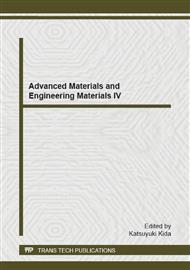[1]
Z. Ma, X. Zheng, W. Liu, X. Lin, and W. Deng, Fast thermal resistance measurement of high brightness LED, in Electronic Packaging Technology, 2005 6th International Conference on, 2005, pp.1-3.
DOI: 10.1109/icept.2005.1564685
Google Scholar
[2]
U. Lafont, H. v. Zeijl, and S. v. d. Zwaag, Increasing the reliability of solid state lighting systems via self-healing approaches: A review, Microelectronics Reliability, vol. 52, pp.71-89, (2012).
DOI: 10.1016/j.microrel.2011.08.013
Google Scholar
[3]
Y. Han, H. Guo, X. Zhang, F. Yin, K. Chu, and Y. Fan, Thermal performance analysis of LED with multichips, Journal of Wuhan University of Technology-Mater. Sci. Ed., vol. 26, pp.1089-1092, 2011/12/01 (2011).
DOI: 10.1007/s11595-011-0368-0
Google Scholar
[3]
H. Jianzheng, Y. Lianqiao, and S. Moo Whan, Thermal and Mechanical Analysis of High-Power LEDs with Ceramic Packages, Device and Materials Reliability, IEEE Transactions on, vol. 8, pp.297-303, (2008).
DOI: 10.1109/tdmr.2008.920298
Google Scholar
[4]
D. L. Zhong, H. Qin, C. H. Wang, and Z. C. Xiao, Thermal performance of heatsink and thermoelectric cooler packaging designs in LED, in Electronic Packaging Technology & High Density Packaging (ICEPT-HDP), 2010 11th International Conference on, pp.1377-1381.
DOI: 10.1109/icept.2010.5582819
Google Scholar
[5]
Y. B. Liu, On Thermal Structure Optimization of a Power LED Lighting, Procedia Engineering, vol. 29, pp.2765-2769, (2012).
DOI: 10.1016/j.proeng.2012.01.387
Google Scholar
[6]
S. J. Dong, Q. Zhou, M. H. Wang, X. Q. Jiang, and Y. J. Yi, Analysis of thermal spreading resistance in high power LED package and its design optimization, in Electronic Packaging Technology and High Density Packaging (ICEPT-HDP), 12th International Conference on, 2011, pp.1-5.
DOI: 10.1109/icept.2011.6067010
Google Scholar
[7]
H. H. Cheng, D. S. Huang, and M. T. Lin, Heat dissipation design and analysis of high power LED array using the finite element method, Microelectronics Reliability, vol. 52, pp.905-911, (2012).
DOI: 10.1016/j.microrel.2011.05.009
Google Scholar
[8]
A. Christensen and S. Graham, Thermal effects in packaging high power light emitting diode arrays, Applied Thermal Engineering, vol. 29, pp.364-371, (2009).
DOI: 10.1016/j.applthermaleng.2008.03.019
Google Scholar
[9]
M.H. Chang, D. Das, P. V. Varde, and M. Pecht, Light emitting diodes reliability review, Microelectronics Reliability, vol. 52, pp.762-782, (2012).
DOI: 10.1016/j.microrel.2011.07.063
Google Scholar


